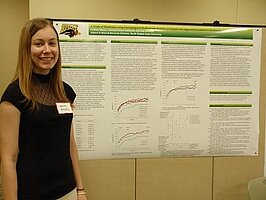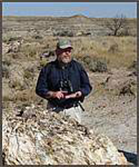Ecosystem Services and Wetland Condition Assessment in the Prairie Pothole Region

Lindsey Meyers (Malum) is a Doctor of Philosophy student in the Natural Resources Management program at North Dakota State University. She holds a Master of Science degree in Natural Resources Management from North Dakota State University and a Bachelor of Science degree in Biology and Mathematics from Jamestown College in North Dakota. Her current research is focused on ecosystem services in North Dakota wetlands. She will be examining different modeling techniques using vegetation, soil, and land use data as well as studying wetland plant uptake of phosphorus, carbon, and nitrogen and how nitrogen isotopes are stored in the soil. She will also compare national and regional assessment methods for wetlands in North Dakota.
Fellow: Lindsey M. M. Malum
Advisors: Edward Shawn DeKeyser, Ph.D., Assistant Professor, School of Natural Resource Sciences, North Dakota State University.
Jack E. Norland, Ph.D., Assistant Professor, School of Natural Resource Sciences, North Dakota State University.
Degree Progress: Ph.D. in Natural Resources Management expected graduation in spring of 2013.
Ecosystem Services and Wetland Condition Assessment in the Prairie Pothole Region
My research will address the state of wetland condition and benefits of ecosystem services in North Dakota wetlands. The extent of anthropogenic disturbance in North Dakota wetlands is currently unknown. Cropping and draining of wetlands are common disturbances in North Dakota and have been for many years, so it is important to document what the types and extent of disturbances are occurring in wetlands across the state. Condition assessments have been developed for North Dakota and other places across the nation; however, a statewide and nationwide condition assessment of wetlands has never been completed. Therefore, in the summer of 2011, the Environmental Protection Agency (EPA) is conducting a National Wetland Condition Assessment (NWCA) across the United States using a certain set of assessment methods. This national project will be the first condition assessment that will set a baseline for wetland monitoring over time. Additionally it is unknown exactly how nutrients such as phosphorus and nitrogen behave in wetland soils and plants, so this will be studied as well in conjunction with the wetland assessments.
Project Objectives:
The objectives of this project are to:
- Provide a condition assessment of North Dakota wetlands
- Compare methods of the NWCA and regional assessments
- Compare wetland plant tissue analysis for phosphorus, carbon, and nitrogen to plant biomass estimates
- Analyze nitrogen isotope data to see how nitrogen is stored in wetland soils
- Develop and assess ecosystem services models for wetlands in North Dakota
Progress:
Permission from landowners to access their land during the summer of 2011 has been completed. Existing data from the U.S. Geological Survey, NDSU, and the U.S. Army Corps of Engineers (COE) was collected for initial modeling in order to illustrate existing plant community attributes which will later be correlated with ecosystem services provided by wetlands.
The North Dakota intensification for the NWCA on 55 wetlands was completed in the summer of 2011. At each wetland, three regional assessments: the IPCI, NDRAM and HGM Model, were also completed. Additionally, plant and soil samples were collected and are being analyzed for nutrient content. Currently, data entry and analysis, statistical analyses, and lab analyses are being performed on data and samples collected during 2011. During the summer of 2012, an additional 18 wetlands which have been managed with sediment removal will be sampled.
Significance:
Scientists, psychologists, and economists are just beginning to study the importance of the services provided by nature. Wetlands are also very important features on the natural landscape that provide a variety of ecosystem services. Estimates of various ecosystem services through statistical modeling can be used in scenarios to estimate how these services will increase or decrease given changes in biological condition, anthropogenic disturbance, and potential climate change in North Dakota. Data on nutrient uptake by wetland plants and how nitrogen cycles in hydric soils will also provide information on how nutrients behave in wetlands. How nutrients are stored and used in wetlands under various land uses can help land managers understand how different land practices affect wetlands. As a better understanding of wetlands and the services provided by them emerges, we can further assess the value of wetlands. Additionally, as the quality of wetlands is important in addition to the quantity, wetland assessments can assist in proper land management. This project seeks to identify optimal wetland assessment methods for the prairie pothole region. It is the goal of this study to provide valuable information regarding the condition and services provided by North Dakota wetlands so that the public and policymakers can have appropriate information to make informed decisions.

Edward Dekeyser
AES School of Nat Res Sciences
Office: Morrill 205B
Telephone: 701-231-8180
Email: edward.dekeyser@ndsu.edu

Jack Norland
School of Natural Resource Sci
Office: Morrill 205A
Telephone: 701-231-9428
Email: jack.norland@ndsu.edu


